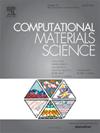Electron-dislocation interactions in electroplastic effects of pure aluminum: Thermal fluctuation-assisted electron wind mechanism
IF 3.1
3区 材料科学
Q2 MATERIALS SCIENCE, MULTIDISCIPLINARY
引用次数: 0
Abstract
The electroplastic effect refers to the intrinsic mechanism by which high-density electric currents significantly enhance the plasticity and mechanical properties of metals. The electron wind force (EWF) mechanism is one of the fundamental principles underlying this effect; however, the interplay of multiple concurrent phenomena has hindered precise elucidation of electron-dislocation interactions. In this paper, we employ molecular dynamics (MD) simulations to investigate electron-driven dislocation behavior in pure aluminum at the atomic level, explicitly incorporating thermal fluctuations—an inherent atomic property—into the analysis. The evolution of dislocation configuration introduced by deformation was further explored based on this model. The results show that EWF induces the directional movement of atoms, and the kink nucleation decreases the critical EWF required for edge dislocation slip from 46.3fN to 0.046fN due to thermal fluctuation. For the metal with high density dislocations, electric current reduces the density of mobile dislocations while leaving immobile dislocation unchanged. This work can help clarify certain controversies surrounding the electron wind mechanism.

求助全文
约1分钟内获得全文
求助全文
来源期刊

Computational Materials Science
工程技术-材料科学:综合
CiteScore
6.50
自引率
6.10%
发文量
665
审稿时长
26 days
期刊介绍:
The goal of Computational Materials Science is to report on results that provide new or unique insights into, or significantly expand our understanding of, the properties of materials or phenomena associated with their design, synthesis, processing, characterization, and utilization. To be relevant to the journal, the results should be applied or applicable to specific material systems that are discussed within the submission.
 求助内容:
求助内容: 应助结果提醒方式:
应助结果提醒方式:


